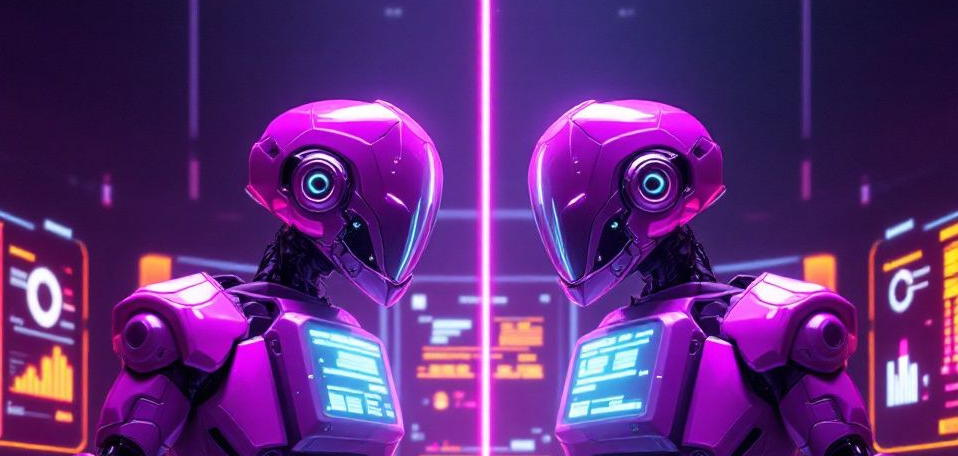Before diving into the specifics of Claude and ChatGPT, it's important to understand what powers these sophisticated AI assistants. At their core, both are chatbots that connect users to large language models (LLMs), which are capable of generating human-sounding language.
These interfaces allow users to interact with powerful AI models through simple text prompts.
The process works like this:
-
You enter text prompts into the chat interface
-
The large language model processes your request
-
The model generates a response based on patterns it learned during training
-
You receive the response in the chat
It seems simple, but the underlying AI systems are enormously complex. They've been trained on vast collections of books, articles, websites, and other text sources to recognize patterns and generate the most likely response.
Claude and ChatGPT share several common features that have made them popular choices among users seeking AI assistance:
-
Chats naturally with human-like writing
-
Summarizes complicated text information and data
-
Remembers what you said earlier in your conversation
-
Progress tracking: Document your AI journey and learning experiences
-
Easy to use without needing specialized technical knowledge
Both platforms excel at understanding context, maintaining coherent conversations, and generating high-quality outputs across a range of tasks. They can both answer simple questions, or produce complex creative outputs – and everything in between.

While these two AI assistants can both chat with you and help with similar tasks, they do have some important differences worth knowing about:
Claude is made by Anthropic, a company that puts a strong focus on building AI that's helpful, harmless, and honest. Their approach centers around making AI that aligns with human values and preferences.
ChatGPT comes from OpenAI, which started as a nonprofit but has since become more commercially focused. Their approach has emphasized pushing the boundaries of what AI can do, sometimes moving very quickly to release new features.
Interestingly, many of the people who founded Anthropic once worked for OpenAI.
Claude tends to be more careful and thoughtful in its responses. It's particularly good at understanding nuance and giving detailed, well-reasoned answers. Many users find Claude to be more "conversational" and human-like in how it responds, and that its outputs tend to be more informative and fact-oriented.
ChatGPT can sometimes be more direct and to-the-point in its conversational style. At the same time, many users also find ChatGPT tends to be more "creative" in its responses. It's often willing to take more risks and generate more imaginative content, which can be great for brainstorming and creative writing.
One big practical difference is that ChatGPT can both understand images you upload AND create new images based on your descriptions. This image generation feature (called DALL-E) lets you create artwork, diagrams, and visuals just by describing what you want.
Claude can understand and analyze images you share, but it can't generate new images. If creating pictures with AI is important to you, this is a significant advantage for ChatGPT. Users with a paid ChatGPT plan even have access to a video generation tool called Sora, which creates moving images based on a text description.
Another major difference is that ChatGPT can search the internet in real-time with its browsing feature. This means it can look up current information, research topics for you, and find the latest news or data.
Claude doesn't have this ability – it can only work with information it learned during its training. and any files you upload to your conversation. This means Claude may not have information about very recent events or the latest data on a topic.

Though it is lacking in image generation and web search capabilities, Claude offers several unique features that set it apart from other AI assistants, including ChatGPT. Let's explore three of its most distinctive features.
Claude's Projects feature works like a digital folder system where you can group related conversations and files. You can also set specific instructions that apply across all conversations in a project. For example, if you tell Claude once to "write in a noir style," and it remembers for every chat in that project.
This feature is particularly useful for:
- Ongoing research initiatives requiring multiple sessions
- Complex writing projects that evolve over time
- Learning journeys on specific topics
- Professional tasks requiring context from multiple documents
ChatGPT has a similar Projects feature for organizing related conversations. However, ChatGPT also offers Custom GPTs, which go beyond organization to create specialized assistants for specific tasks. Think of Custom GPTs as building your own AI expert on particular topics or documents.
Both platforms let you organize conversations similarly, but ChatGPT's Custom GPTs can store more reference material (like entire manuals or datasets) than either project system can. This gives ChatGPT an edge for specialized, information-heavy tasks, though both platforms handle basic project organization equally well.
Claude's Artifacts feature genuinely sets it apart from other AI assistants. Unlike typical AI outputs that blend into the conversation, Artifacts are standalone, professionally formatted pieces of content that exist independently within your chat.
Think of Artifacts as polished documents ready for use right out of the box. Instead of copying text and reformatting it yourself, Claude delivers complete, ready-to-use content with proper structure, formatting, and organization already applied.
With Artifacts, Claude can build:
- Formatted documents with proper headings, sections, and styling
- Simple visual diagrams and charts to illustrate concepts or data
- Presentations with organized slides and visual elements
And, you can go beyond just static text – many Artifacts can be interactive and publishable to the web. You can create interactive web content that you can share with others, like forms and surveys, or educational materials like quizzes, flashcards, and learning exercises that you can share with your students.
Building on the Artifacts feature, Claude gives you some really handy editing tools that let you refine and improve your content bit by bit. There are two main ways Claude lets you edit:
Update: You can fix just one part of your document without touching the rest
Rewrite: You can completely redo the whole thing while keeping the same format
This makes working with Claude feel more like having a real partner for your writing projects.
You can highlight the text you want to adjust, and then just say things like "just fix the introduction" or "rewrite the paragraph to be more engaging." Claude will make those specific changes for you while you watch. If you don't like it, you can use the version control feature to go back.
So which AI assistant is right for you? It really comes down to how you work and what you're trying to accomplish. Here's a simple way to think about it:
-
You regularly work with long-form content requiring nuance and depth
-
You need structured outputs like formatted documents or diagrams
-
Your workflow involves iterative document development
-
You heavily rely on third-party integrations and plugins
-
Advanced image generation is central to your needs
-
You want a customized assistant that has access to a large personal knowledge base
I've been using both Claude and ChatGPT for a couple months now, and I've found myself reaching for different assistants depending on what I'm working on. When I'm drafting long-form content or need to organize complex ideas, I often prefer Claude's thoughtful approach and document capabilities. For quick creative brainstorming or when I need to generate images, ChatGPT is my go-to.
The truth is, there's no single "best" AI assistant. The right one for you is the one that fits how you work, and can help you accomplish your goals. Some days I switch between them both, letting each do what it does best. If you're on the fence, I'd recommend trying both for a few weeks to see which one feels more natural to your workflow.
Either way, it's probably too soon for anyone to pick their "favorite" AI assistant. These tools will keep evolving rapidly, bringing new features and capabilities we haven't even imagined yet. The best strategy isn't to pick one platform and stick with it forever, but to stay curious, keep experimenting, and find the tools that help you think better, and create more.
Empty space, drag to resize



